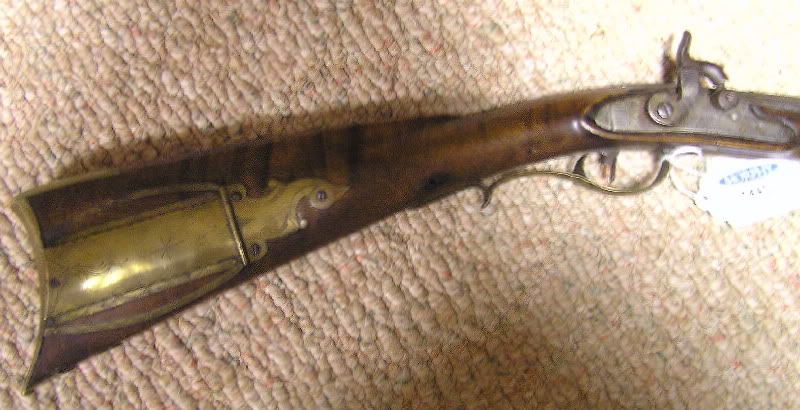
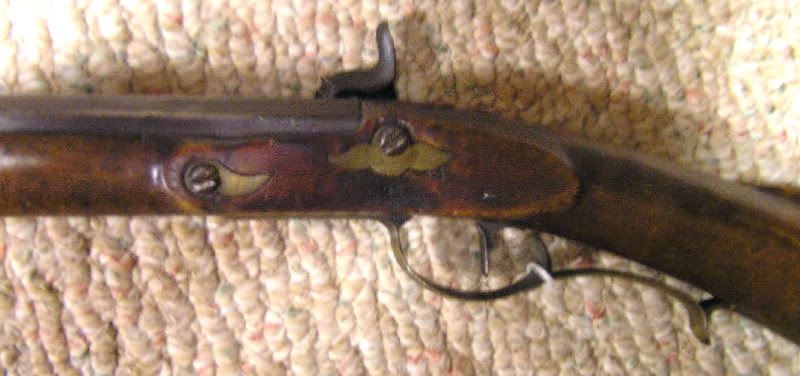
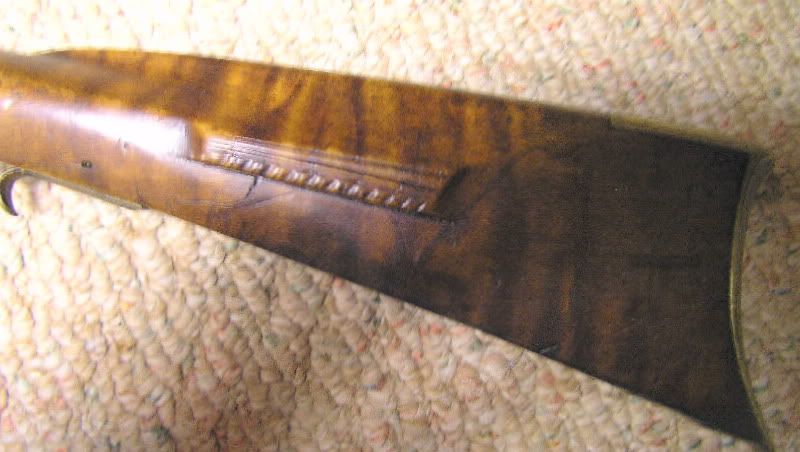
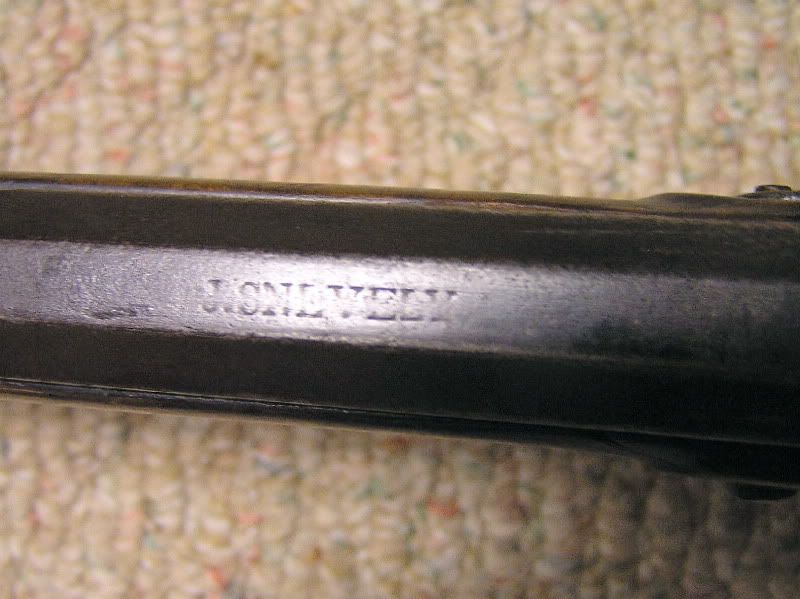
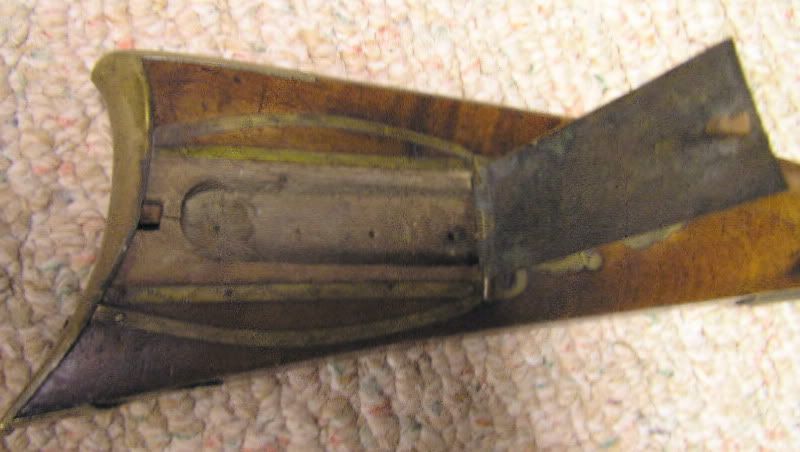
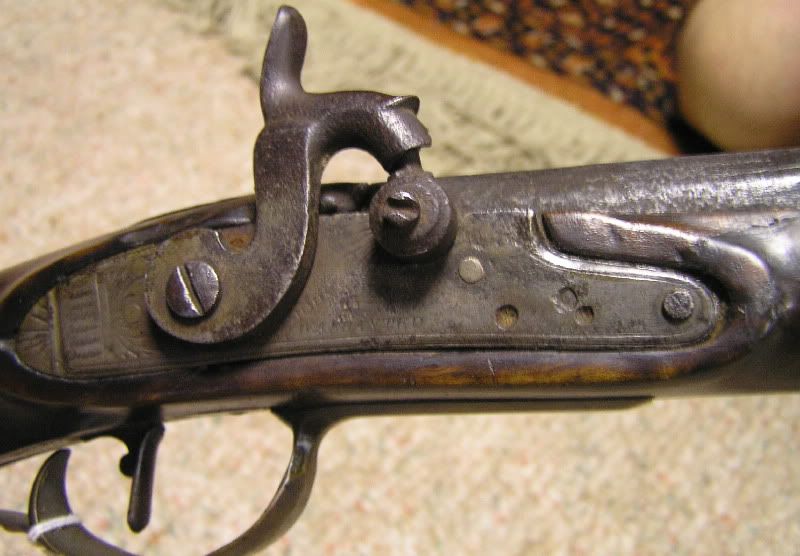
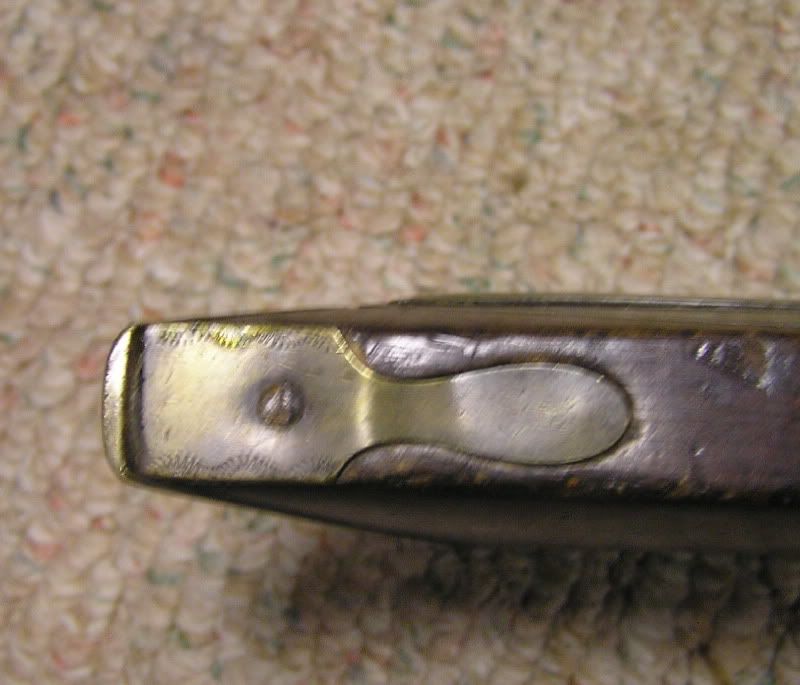
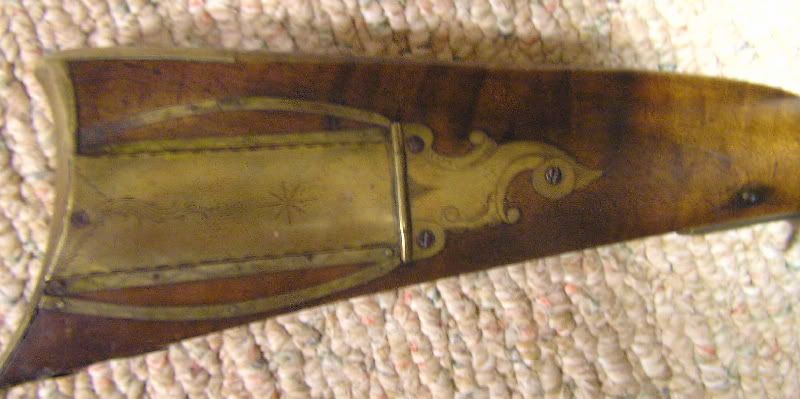
Comments:
Nice rifle from a rarely seen maker; and a Harrisburg gun, too. Appears to be in an 'as-found' condition and shows good honest wear. It certainly deserves a place in the Library. So, send it on, if you would. It's the kind of gun that we all would like to own.
------------------------------------------------------------------------------------------------
View Profile Email Personal Message (Offline)
A few comments on Harrisburg/Dauphin County rifles
« on: August 16, 2009, 08:42:47 PM » Reply with quote Modify message Remove message Split Topic
From the pre-Rev period onward, Harris Ferry, the forerunner of present-day Harrisburg, PA, was an important crossing point on the mile-wide Susquehanna River. Also, many woodland Indian paths were nearby. There were early gunsmiths in the region. James Chambers worked at Fort Hunter, just north of Harris Ferry, and was killed there in 1763 in an Indian attack. The area also had golden age grand masters but they are few in number. At this time, the Harrisburg area was still an outpost compared to York and Lancaster. The trade and commerce expanded at a later date in Harrisburg as it did in Dauphin County as a whole. Actually, there has been little written about Dauphin County guns, and less yet about those originating in Harrrisburg and the contiguous townships.
A bit of background may help someone unfamiliar with the territory to understand the issues pertaining to these rifles. First, in Thoughts on the Kentucky Rifle in Its Golden Age Kindig, being one of the first to comment on the school, did enter some misleading material which was later rectified by Dr. Shumway in his annotated editions. While it is true that the school presents fewer distinctive regional characteristics than many of the other classic schools, Kindig included and gave much importance to Peter Berry as a Dauphin County builder. Actually, Berry worked in Annville, now Lebanon County, which has always been considered as part of the "Pa. Dutch" region. He would have been more appropriately linked to N. Beyer who had a shop likely about a 5 minute horse ride away in South Annville Township. Incidentally, the following issue often complicates studies of local guns. At first, all the area west of Bucks and Chester County was considered to be part of Lancaster County. It ran the whole way to the western end of the Commonwealth. In 1785 Dauphin County was carved out of Lancaster County, being named for the King of France's son. In 1813 Lebanon County was partitioned from Lancaster and a small sliver of Dauphin County. Hence a man like Beyer was a tax payer in three counties over his lifetime and he never moved an inch.
Now for some more orientation. The county is bisected by the Blue Mountain Range, creating two distinct areas. Northern Dauphin County had its important makers, and some of them were relatively early. Leonard Reedy of Gratz comes to mind, as does Peter Bellis who worked out of Lykens. To the south of the mountains is Lower Dauphin County (LDC), encompassing Harrisburg, Lower Paxton Twp., Swatara Twp., Hanover Twp. and Derry Twp. (Hershey). Included is Middletown, the oldest incorporated municipality in the county, taking its name for being in the middle of Lancaster and Carlisle on the old original PA "turnpike."
In brief, you can expect to see more Berks Co. influence and upper-Susquehanna-type motifs on the upper-county guns, and, by split decision, I would generalize that Lancaster was more of an influence on lower-county guns. This is likely the case not only due to geography, but because several important lower county builders apprenticed in Lancaster. For instance, John Brooks and Christian Siple both worked in Lancaster prior to moving to the region. Siple was an apprentice of Jacob Haeffer.
Now back to the main subject. As there is relatively little information available on Harrisburg/LDC firearms, here's a start. For this area, perhaps the most important grand master of the golden age was Martin Shell. You can view several fine M. Shells in Kindig's book. Note the small number of golden age Dauphin guns that appear in his book. He didn't run across many. Hasty conclusions are often drawn from this and the paucity of other documentation that the guns were not very definitive or important, and that the region must have played a small role in the development and production of the rifles.
Nothing could be farther from the truth. The fact is, Harrisburg's greatest contributions were post-golden age. Harrisburg developed later than its sister cities, but when it did develop there was still a need for firearms, and now Harrisburg was the "jumping off point" for those headed for the frontier. Business must have been brisk, because Dr. Shumway listed no less than sixty-four (64) documented lower county gunsmiths in his unpublished list of 1972. I am not including those who lived north of the mountains. Shumway planned a book on Dauphin guns, but, according to him, the problem was that there were not that many guns to photograph at the time and so the project got put on a back burner.
Yes, when placed side-by-side, Dauphin guns are less homogeneous than a similar grouping of, say, Lancaster or Lehigh guns. Individuality prevailed. Some of the regular characteristics of post-golden age Hbg./LDC rifles are longer-than-normal barrels for this time period, sleekness of architecture, and absence of extreme embellishment. Off center patch boxes are not uncommon, but not as blatant as what Kindig mentions, as he probably had Peter Berry in mind when he accentuated that detail. Patch boxes, when they are there, are normally well done with simple engraving. The engraving is often light and graceful. An exception is the engraving of John Shell, who really cut in deeply, reminiscent of M. Fordney but with a less accomplished hand. Patch boxes normally consist of 4 pieces and the sideplates are often thin and bowed, with exposed wood between them and the lid.
Harrisburg products have surfaced in my lifetime on more than one occasion on routes west of town heading toward Pittsburgh, and as far south as Winchester, VA heading down the mountain range. This comes as no surprise to me as Harrisburg was, at that time, a place to supply one's self for entry into the frontier. Many of these guns carried south and west were likely used up and mutilated, as usual. Incidentally, people who collect stoneware have traced similar routes for the movement of Harrisburg pottery.
Below is a list of the most important Harrisburg/LDC gunsmiths, in my opinion, with brief comments. All warrant further research; perhaps a master's thesis topic for a history/American studies major. Also, it would be great to see this forum come up with more pictures of guns by these makers. This would be a useful addition to the understanding of these rifles. Personally, I would like to have more support for, or be proven wrong on some of my generalizations. That's how research works; let the facts speak for themselves. Right now we need to amass a photo bank of these specimens for further study. This is something wherein the Internet may be of value.
Selected list of LDC gunsmiths:
John Brooks, worked in early 1800's in Hbg. Started in Lancaster.
Amos Early, Lower Paxton/Hanover Twps. Worked w/ J. Shell. Died 1904.
John Ford, Listed from 1830's in Hbg. Supt. of armory here, too. Died 1862.
David Glassbrenner, Hbg., Worked from 1820's. Died 1872.
Philip Heckard, Lower Paxton, Active through 1850's, Lower Paxton Twp.
Benedict Imhoff. 1780-1800 era, Middletown and contiguous townships.
Kelker and Brothers. Lock makers, Harrisburg, 1840's
Christian Klein. Early 1800's. Died 1825.
George Kunkle, 1830-1860, Hbg., Died 1869
Simon Lingle, 1850, Derry Twp. (Hershey area).
Jacob Roop, Sr. 1805, Lower Paxton
Jacob Roop, Jr. 1820 era, Lower Paxton
Daniel Shell, Lower Paxton, Died 1864
John Shell, his brother, Lower Paxton/Hanover Twps. Died 1871
Martin Shell, their father, master of Rev. era, Lower Paxton Twp. 1737-1796
Christian Siple, Middletown/Swatara Twp., Died circa 1827.
Jacob Snevely (Snavely), active circa 1810, Harrisburg.
I know of extant specimens for all of these makers with the exception of Benedict Imhoff.
A series of quick snapshots of a signed J. Snevely should eventually get melded with this report. Snevely worked in Harrisburg. We've known of him for a while; he was listed in Henry Kauffman's 1960 book. The rifle is 57" overall with a 13"pull. It has a 42 1/2" full-octagon barrel, straight rifled, .50 cal. Light, functional, well built rifle. The percussion conversion was neatly done on a flint lock plate made by John Walker. Walker worked in Lancaster Boro so the specimen is pure Pennsylvania. Clean breaks have been repaired; no replaced wood. An honest gun.

